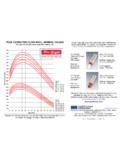Transcription of Ventilator Waveforms: Interpretation
1 Ventilator Waveforms: InterpretationAlbert L. Rafanan, MD, FPCCPP ulmonary, Critical Care and Sleep MedicineChong HuaHospital, Cebu CityTypes of Waveforms Scalarsare waveform representations of pressure, flow or volume on the y axis vstime on the x axis Loopsare representations of pressure vsvolume or flow vsvolume Scalar WaveformsLoopCommon problems that can be diagnosedby analyzing Ventilator waveformsAbnormal ventilatoryParameters/lung Overdistension,Auto PEEPCOPDP atient- Ventilator flow starvation,Double triggering,Wasted effortsActive expirationVentilatorycircuit related auto cycling andSecretion build up in theVentilatorycircuitLung Mechanics Use Scalar Pressure Time waveform with a square wave flow patternUnderstanding the basic Ventilator circuit diagramventilatorDiaphragmEssentially the circuit diagram of a mechanically ventilated patient can be broken down into two Ventilator makes up the first part of the circuit. Its pump like action is depicted simplistically as a piston that moves in a reciprocating fashion during the respiratory patient s own respiratory system makes up the 2ndpart of the circuit.
2 The diaphragm is also shown as a 2ndpiston; causing air to be drawn intothe lungs during two systems are connected byan endotrachealtube which we can consider as an extension of the patient s TubeairwaysChest wallUnderstanding airway pressuresThe respiratory system can be thought of as a mechanical system consisting of resistive (airways +ET tube) and elastic(lungs and chest wall) elements in series DiaphragmET TubeairwaysChest wallPPLP leural pressurePawAirway pressurePalvAlveolar pressureET tube + Airways(resistive element)Resistive pressure varies with airflow and the diameter of ETT and resistanceThe elastic pressure varies with volume and stiffness of lungs and chest = Volume x 1/CompliancePaw= Flow X Resistance +Volume x 1/ComplianceTHUSL ungs + Chest wall(elastic element)Airways + ET tube(resistive element)Lungs + Chest wall(elastic element)Let us now understand how the respiratory systems inherent elastanceand resistance to airflow determines the pressures generated within a mechanically ventilated tubeRairwaysRawUnderstanding basic respiratory mechanicsThe total airway resistance (Raw)in the mechanically ventilated patient is equal to the sum of the resistances offered by the endotracheal tube (R ET tube)and the patient s airways ( R airways)The total elastic resistance(Ers)offered by the respiratory system is equal to the sum of elastic resistances offered by the Lung E lungsand thechest wall E chest wallElungsEchest wallThus to move air into the lungs at any given time (t),the Ventilator has to generate sufficient pressure (Paw(t)) to overcome thecombined elastic (Pel(t))and resistance (Pres(t))propertiesof the respiratory system ErsET TubeairwaysThus the equation of motion for the respiratory systemisPaw (t)=Pres(t)+Pel(t)
3 VentilatorDiaphragmPpeakPresRET tubeRairwaysPresPplatUnderstanding the pressure-time waveformusing a square wave flow patterntimepressureThe pressure-time waveform is a reflectionof the pressures generated within the airways during each phase of the the beginning of the inspiratory cycle,the Ventilator has to generate a pressure Presto overcome the airway : No volume is delivered at this this, the pressure rises in a linear fashionto finally reach Ppeak. Again at end inspiration, air flow is zero and the pressure drops by anamount equal to Presto reach the plateau pressure Pplat. The pressure returns to baseline during passive waveforms using a square wave flow patternThis is a normal pressure-time waveformWith normal peak pressures (Ppeak);plateau pressures (Pplat )and airway resistance pressures (Pres)timepressurePresPplatPresScenario # 1 Paw(peak)= Flow x Resistance +Volume x 1/ Compliancetimeflow Square wave flow patternPaw(peak) waveform showing high airways resistanceThis is an abnormalpressure-time waveformtimepressurePpeakPresPplatPresSc enario # 2 The increase in the peak airway pressure is drivenentirely by an increasein the airways resistancepressure.
4 Note the normal plateau ET tubeblockagePaw(peak)= Flow x Resistance + Volume x 1/ Compliance + PEEP timeflow Square wave flow patternNormalWaveform showing increased airways resistancePpeakPplatPres Square wave flowpatternWaveform showing high inspiratoryflow ratesThis is an abnormalpressure-time waveformtimepressurePaw(peak)PresPplatPr esScenario # 3 The increase in the peak airway pressure is caused by high inspiratory flow rate and airways resistance. Note the shortenedinspiratory time and high high flowratesPaw(peak)= Flowx Resistance + Volume x 1/compliance + PEEP timeflow Square wave flow patternNormalNormal (low) flow rateWaveform showing decreased lung compliance This is an abnormalpressure-time waveformtimepressurePresPplatPresScenari o # 4 The increase in the peak airway pressure is drivenby the decreasein the lung airways resistance is often also a part of this ARDSN ormaltimeflow Square wave flow patternPaw(peak)Paw(peak)
5 = Flow x Resistance + Volume x 1/ Compliance + PEEPC ommon problems that can be diagnosedby analyzing Ventilator waveformsAbnormal ventilatoryParameters/lung Overdistension,Auto PEEPCOPDP atient- Ventilator flow starvation,Double triggering,Wasted effortsActive expirationVentilatorycircuit related auto cycling andSecretion build up in theVentilatorycircuitRecognizing Lung OverdistensionFlow-time waveform Flow-time waveform has both an inspiratory and an expiratory arm. The shape of the expiratory arm is determined by: the elastic recoil of the lungs the airways resistance and any respiratory muscle effort made by the patient during expiration (due to patient- Ventilator interaction/dys=synchrony) It should always be looked at as part of any waveform analysis and can be diagnostic of various conditions like COPD, auto-PEEP, wasted efforts, overdistentionetc. Recognizing lung overdistensionThere are high peak and plateau this when:PEARL: Think oflow lung compliance ( ARDS),excessive tidal volumes, right mainstemintubation etcAccompanied by high expiratory flow ratesThe Stress Index In AC volume ventilation using a constant flow waveform observe the pressure time scalar.
6 Normal, linear change in airway pressure Stress index =1 Upward concavity indicates decreased compliance and lung overdistensionStress index > 1 Downward concavity indicates increased compliance and potential alveolar recruitment Stress index < 1flowtimePawNote: Patient effort must be absentThe Stress IndexPressure-volume loop Lower inflection point (LIP)Can be thought of as theminimum baseline pressure (PEEP)needed for optimalalveolar recruitmentUpper inflection point (UIP)above this pressure, additional alveolar recruitmentrequires disproportionateincreases in applied airway pressureCompliance (C)is markedly reduced in the injured lung on the right as compared to the normal lungon the leftNormallungARDSO verdistensionUpperinflectionpointPeakins piratorypressureNote:During normal ventilation the LIP cannotbe assessed due to the effect of the inspiratory flow which shifts the curve to the rightRecognizing Auto-PEEPD ynamic Hyperinflation (Gas Trapping) Dynamic hyperexpansion, defined as premature termination of exhalation, often occurs when respiratory rate, inspiratory time, or both have been increased.
7 By not permitting exhalation to finish, an increase in mean airway pressure results. Gas trapping may occur leading to an elevation in PCO2. Careful attention must be paid to dynamic hyperexpansionin patients with obstructive lung disease whose long time constants and slow emptying can result in progressive air trapping, hypercarbia, and eventually decreased cardiac flow continues and fails to return to the baseline prior to the new inspiratory cycleDetecting Auto-PEEPR ecognize Auto-PEEP whenExpiratory flow continues and fails to return to the baseline prior to the newinspiratory cycleThe development of auto-PEEP over several breaths in a simulation Notice how the expiratory flow failsto return to the baseline indicatingair trapping(AutoPEEP)Also notice how air trapping causes an increase in airway pressuredue to increasing end expiratorypressure and end inspiratory lung how flow rates affect I/E ratios and the development of auto PEEPL luis Blanch MD, PhD et al.
8 Respiratory Care Jan 2005 Vol 50 No 1 Decreasing the flow rateIncrease the inspiratorytimeand consequently decrease theexpiratory time(decreased I/E ratio)Thus allowing incomplete emptying of the lung and the developmentof air trapping and auto-PEEPU nderstanding how inspiratorytime affect I/E ratios and the development of auto-PEEP In a similar fashion, an increase in inspiratorytime can also cause a decrease in the I: E ratio and favor the development of auto-PEEP by not allowing enough time for complete lung emptying between Expiratory Flow Limitation ( COPD, asthma)Recognizing prolonged expiration (air trapping)Recognize airway obstructionwhenExpiratory flowquickly tapers off and then enters a prolongedlow-flow state without returning to baseline (auto-PEEP) This is classic for the flow limitation and decreased lungelastancecharacteristic of COPD or status asthmaticusCommon problems that can be diagnosedby analyzing Ventilator waveformsAbnormal ventilatoryParameters/lung Overdistension,Auto PEEPCOPDP atient- Ventilator flow starvation,Double triggering,Wasted effortsActive expirationVentilatorycircuit related auto cycling andSecretion build up in theVentilatorycircuitPATIENT- Ventilator INTERACTIONSW asted effortsDouble triggeringFlow starvationActive expirationVentilator Dyssynchrony.
9 Inaccurate Sensingof Patient s Effort Many modern ventilators sense patient effort by detecting decreases in airway pressure or flow between the inspiratory and expiratory limbs of the circuit. Inadequate sensing of patient effort leads to tachypnea, increased work of breathing, Ventilator dyssynchrony, and patient discomfort. Flow triggering is often used in children, as it is very sensitive to patients with minimal respiratory effort and small endotracheal tubes. Dyssynchronyalso occurs when an air leak leads to loss of PEEP, resulting in excessive Ventilator triggering (auto cycling). The unstable pressure baseline that occurs due to leak may be misinterpreted as patient effort by the ineffective/wasted patient effortPatient inspiratoryeffortfails to trigger vent resulting in a wasted effortResults in fatigue, tachycardia, increased metabolic needs,fever etcCauses: High AutoPEEP, respiratory muscle weakness, inappropriate sensitivity settingsRecognizing double triggeringContinued patient inspiratoryeffortthrough the end of a deliveredbreath causes the Ventilator to triggeragainand deliver a 2ndbreath immediately afterthe first breath.
10 This results in high lung volumes and peak airway pressures anddouble the inspiratoryvolumeCauses: patient flow or volume demand exceeds Ventilator settingsConsider: Increasing tidal volume, switching modes pressure support, increasing sedation or neuromuscular paralysis as appropriateVentilator Dyssynchrony: Inadequate VentilatorySupport Inadequate ventilatorysupport occurs when patient effort is not satiated by the inspiratory flow of the mechanical breath. As a result, patients attempt to initiate breaths during a mechanical breath. This phenomenon is seen as a reduction of airway pressure, seen as a decrease in airway pressure tracing during inspiration (flow dyssynchrony). In volume-limited ventilation a reduction of the inspiratory pressure as a result of dyssynchronouspatient effort can translate into a higher PIP. Titration of flow rate, decreasing inspiratory time, or changing the mode of ventilation can help meet a patient s inspiratory example of double triggeringRecognizing flow starvationLook at the pressure-timewaveformIf you see this kind of scooping or distortion insteadof a smooth rise in the pressure flow starvation in the setting of patient discomfort, fatigue, dyspnea, etc on the ventRecognizing active expirationLook at the flow-time& pressure-timewaveformThe patient s active expiratory effortsduring the inspiratoryphase causes a pressure spike.










